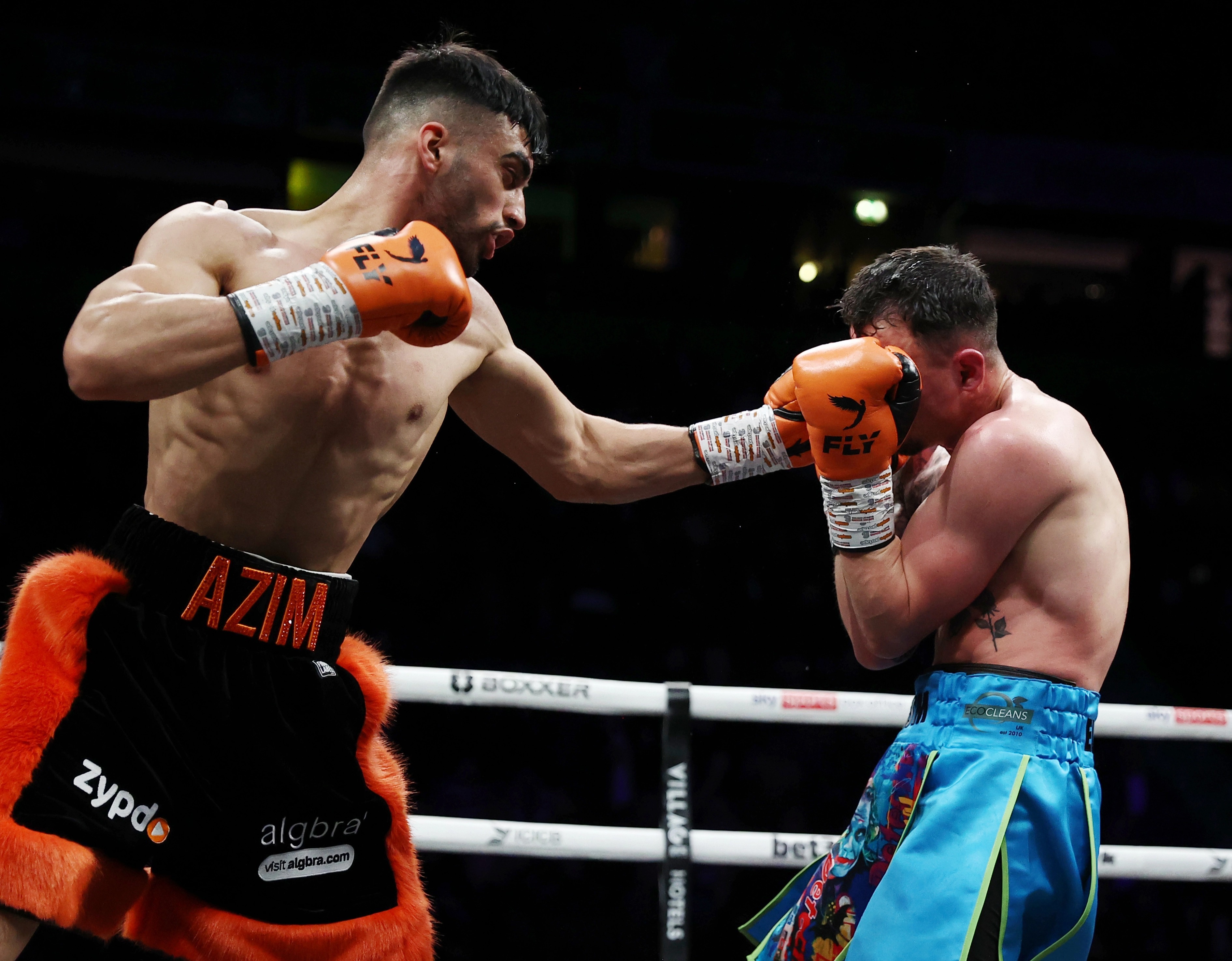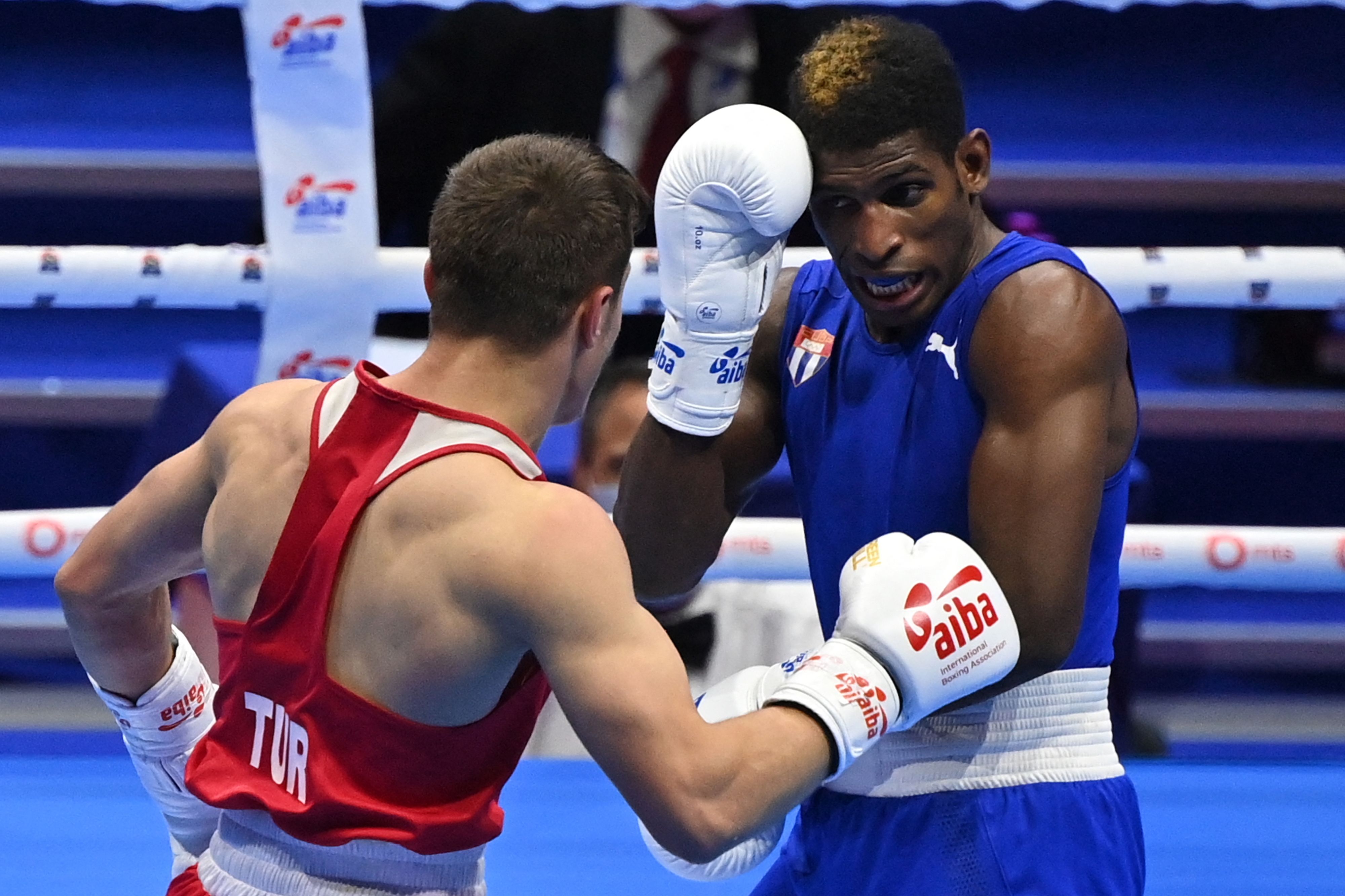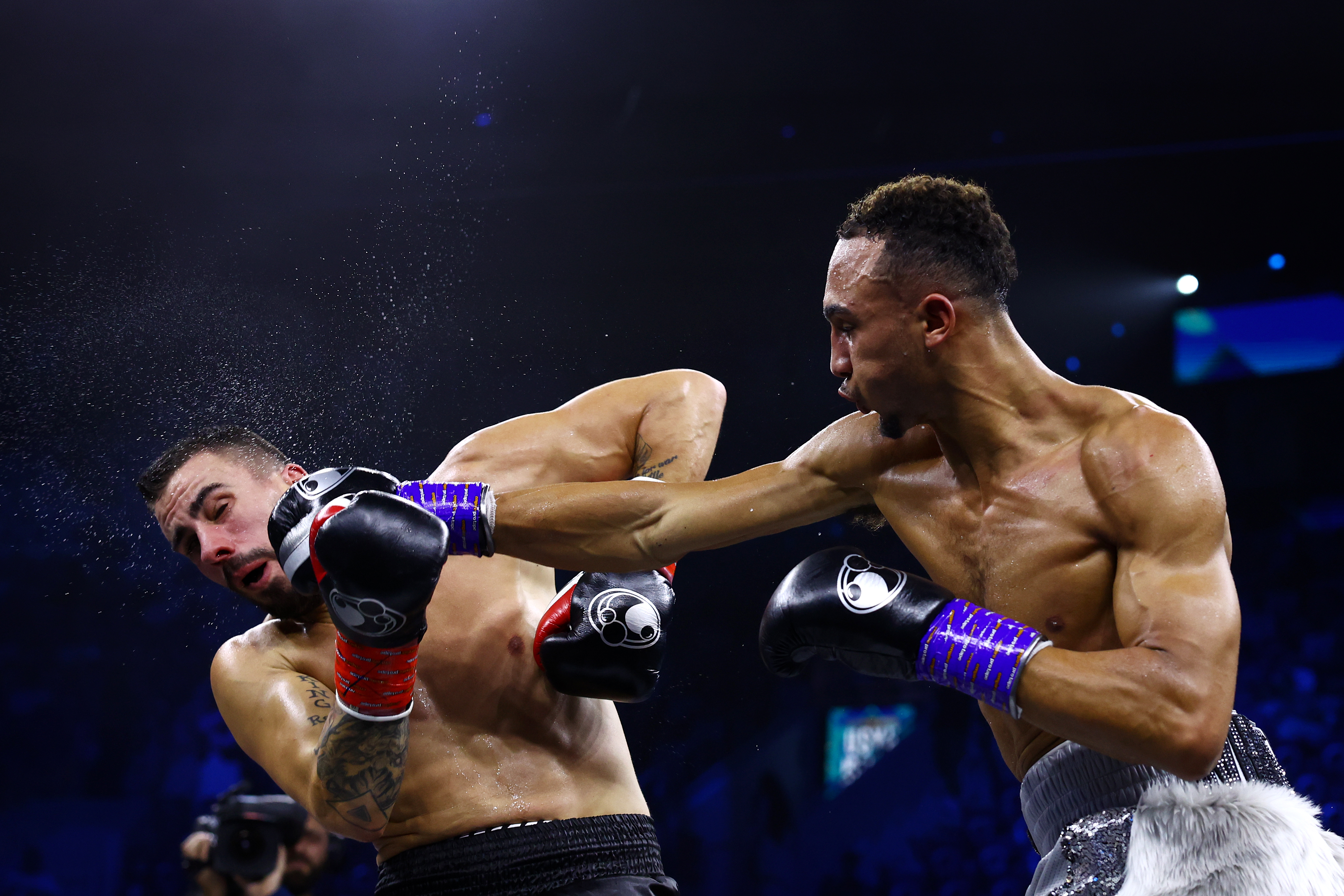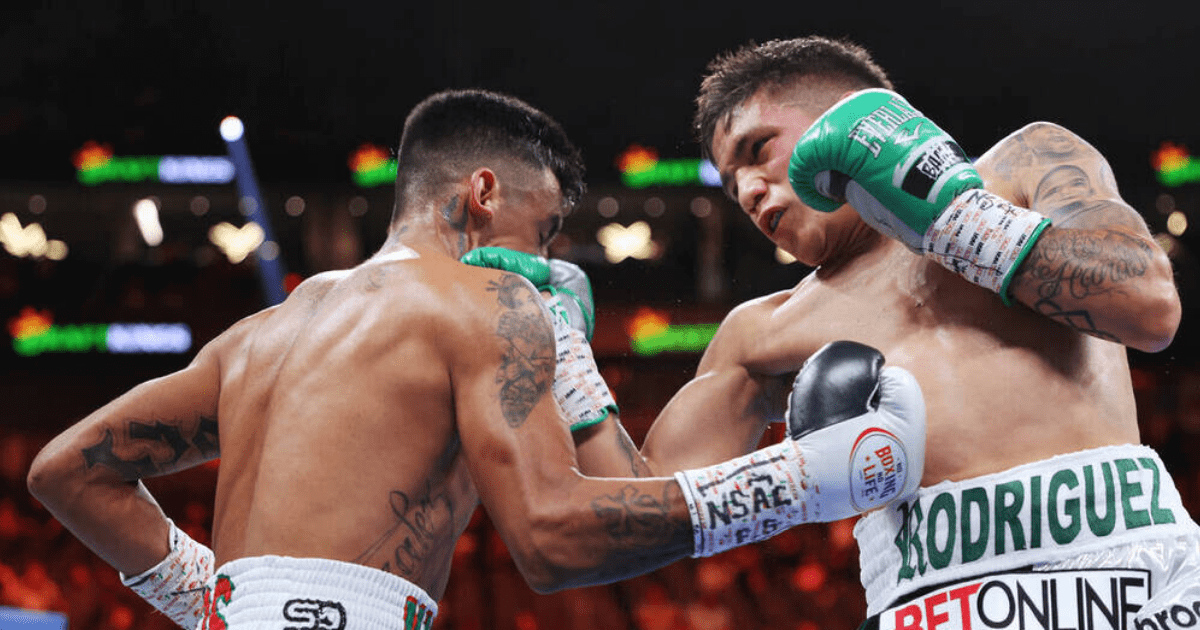BOXING superstars can be moulded over years and years or spring up overnight – and in 2022 we saw a fine mix.
With amateur boxing in growing disarray and facing the axe from the Olympics, we are on a miserable course to lose a crucial part of the sport.
Jesse Bam Rodriguez, right, is being tipped for a bright future in boxing
Recent Games have provided us with iconic names and glistening golds like James DeGale, Anthony Joshua, Luke Campbell, Nicola Adams, Galal Yafai and Lauren Price.
And if that route into the pro ranks is robbed from fighters and fans alike by bungling bureaucrats, then we all lose out.
Thankfully these starlets have emerged just before the dismal turn of events and could bring some joy to our screens in 2023.
SunSport runs down FIVE stars to look our for in the new year…
Jesse Bam Rodriguez
The 22-year-old Mexican-American southpaw grabbed the super-flyweight world title in February – as a late stand-in challenger – and defended twice by September in stylish throw-back fashion.
At just 5ft 4in the pocket rocket has power, as well as skill and guts, with 11 of his 17 wins inside the distance.
Hardcore boxing fans are already purring about this new ace but casuals should take a look at the lower waits to catch a glimpse of this young talent.
CASINO SPECIAL – BEST NEW CUSTOMER SIGN UP DEALS
Moses Itauma
In April, aged just 17, this Kent ace won gold at the European Youth champions with FOUR first-round finishes.
The brother of light-heavyweight Frank Warren prospect Karol Itauma, the wonderkid laid waste to his super-heavy division to take top spot on the podium.
The Olympics feel a lifetime away and there will be huge intrigue to see what the punching prodigy does when he turns 18 and free to turn professional.
On the circuit there are already shocking stories of young novice Itauma travelling the country and bashing up some of our most highly regarded professional cruisers and heavies in sparring – sometimes even being told never to return for fear of unravelling their confidence.
Moses Itauma burst onto the scene in 2022 and could go on to great things
Adam Azim
This 20-year-old super-light ace has everyone in British boxing excited for plenty of reasons.
The Shane McGuigan-trained starlet has raced through his first few fights, celebrated them with some sensational gymnastics and promised plenty more.
Sky Sports are so excited by the Slough ace that they built their November 27 Sunday afternoon show around the rising ace.
Doors at the iconic Ally Pally opened at midday and finished by 7pm in a brilliant bid to get a whole new generation of young fight fans excited by the sport and Azim.
And if he can follow in the footsteps of his idol Amir Khan then he can change the face of the sport again – like his Bolton hero did – over the next decade.
 Adam Azim is being tipped for huge things, with Amir Khan a huge admirer
Adam Azim is being tipped for huge things, with Amir Khan a huge admirer
Andy Cruz
Aged 27 it might appear silly to call his amateur standout a prospect but his home nation of Cuba does not allow their boxers to turn professional.
But rumours are growing that the 2020 Olympic lightweight gold winner has defected and fled his home, with a view to turning over.
The light and super-light divisions – with brilliant young talents like Ryan Garcia, Devin Haney, Teofimo Lopez and Gervonta Davis – are some of the most exciting.
But, without the star names fighting each other, it is also one of the most frustrating.
But if Cruz can parachute in – with no time to waste – he could really mix things up.

Andy Cruz, right, is believed to have defected from Cuba and could now be able to turn professional
Ben Whittaker
When the Brummie ace only landed a silver at the 2020 Olympics he upset a few sad saps for not celebrating what he felt was a failure.
But that mindset should be celebrated among our elite athletes.
The light-heavy ace has not changed his approach in the pros either, causing a stir when he made his debut in July with a ruthless and flashy performance.
And he shot from the lip when he boxed on the Oleksandr Usyk vs Anthony Joshua undercard and had a dig at the talent at the pre-fight press conference and joked about being scheduled to fight so early they would still be building the ring.
Watch out for everything this 25-year-old lad does – and says – in and outside of the ring.

Ben Whittaker, right, is attracting plenty of fans with his performances, in and out of ring
Frequently Asked Questions
How to throw the jab
Here’s a step-by, easy guide on how to throw a jab.
- With both feet, move forward
- Lift your arm up above your shoulder.
- Your target is at your feet.
- After hitting your target you should swing your arm up.
- Steps 1 through 4 can be repeated.
How many punches can a human take?
A punch is defined as “a blow delivered from a fist”. Only one punch can be sustained by a human. When someone hits you in the face, he/she is punching you. You can’t hit them/her back. It would be impossible to hit him/her back with two punches.
How many hours do boxers train in a single day?
Boxing trainers work out for at least 4 hours each day. They spend time learning new moves and practice their punches, as well as studying boxing techniques. Boxers often spar up to 10 times a week.
How to protect yourself
When you’re being attacked, you must always protect your head. You want to avoid being punched. To avoid being punched, you must learn how to stop an incoming punch. Here’s the way to do it.
- Stand tall and square yourshoulders.
- Keep your elbows in line with your sides.
- Block the incoming punch by using your forearm.
- Counterattack immediately.
- Keep blocking until the attacker flees.
- Keep fighting for your rights.
Statistics
- This article received 39 testimonials and 89% of readers who voted found it helpful, earning it our reader-approved status. (wikihow.com)
- You want to be running at roughly 75-80% of your top speed..5 mile slow, easy recovery jog at the end.[6]X Research source 2Mix in long runs, shadow boxing, and short sprints on non-interval days. (wikihow.com)
External Links
amazon.com
- Amazon.com: Ringside Diablo Wrestling Boxing Shoe – Clothing, Shoes & Jewellery
- Amazon.com – Sanabul Boxing Elastic Handwraps 180in Red : Sports & Outdoors
expertboxing.com
How To
Here are some basic skills in boxing
How to box effectively
Boxing is a popular sport. It is made up of two competitors who aim to knock the head off each other. Each country has its own rules. There are three types generally of boxing: Amateur (Professional) and Olympic (Olympic).
Amateur boxing may be done at school, college, and university. This type includes sparring sessions using padded gloves, but without protection. Usually amateur boxing competitions consist of three rounds of five minutes each. There are many types of amateur boxing: Kickboxing, Muay Thai and Taekwondo.
Boxing is often practiced in gyms or clubs. They use protective equipment, such as mouthpieces, nose guards, shin protectors, elbow pads knee pads, waist belts and groin protectors. Six rounds of professional boxing last four minutes each. There are many styles to professional boxing.
Olympic boxing is done at the Olympics. Boxers are required to wear international standards-compliant protective gear. Each round lasts three minutes and is made up of eight rounds. There are only two styles of Olympic boxing; Light Flyweight and Heavyweight.
Boxing is based on the following skills:
- Punching techniques
- Guarding techniques
- Footwork
- Stance
- Move your body
- Defense
- Combination
- Rotation
- Spare parts
Punching Techniques
There are seven types: Left Hook (right hook), Right Hook (uppercut), Cross (cross), Straight, Overhand, Underhand. Each punch has its own technique. Some punches are more powerful than others. For example, an uppercut requires great force. A straight punch on the other side requires less power, but is more effective than other punches.
There are many combinations of punches. These are combinations of punches which work together to achieve a goal. One combination can have many parts. For example, a left hook followed by a right cross will cause damage to the opponent’s jaw.
Guard Techniques
A boxer uses his body to protect himself against attacks. He does this by using his legs.
Legs
Boxers should use their legs to defend against kicks. He raises his leg when he is hit with a kick and then moves away from the opponent. To avoid being kicked on his side, he will bend his knees if the attack is from the front. If the attack comes from behind, however, he can stand straight up and block the kick by his foot.
Elbows
Elbow strikes are very effective because they inflict much pain. You can deliver an elbow strike directly or indirectly. Directly means you hit your opponent directly with your forearm. While indirectly, it means you hit him with another section of your arm.
Hands
Boxers use both their hands and arms to prevent incoming blows. Boxers raise their fists to block incoming blows and then move in the direction of the attacker’s attack. They then make contact with their attacker’s fist.
Knees
When receiving a blow to the stomach, abdomen or chest, a boxer should bend his knees to absorb the impact. For defense purposes, knee strikes are common.
Feet
If he is being attacked, a boxer must take a step back and counter-attack. He can then gain distance from his opponent. In addition, when delivering a counter-attack, a boxer should keep his balance.
Stances
Boxing effectively requires a boxer to have a good stance. How he defends his self will depend on how he stances. It is how he positions himself and where he faces the opponent. Boxers have many stances to choose from. These are some of our most favorite:
- Low stance
- High stance
- Southpaw stance
- Western stance
Body Movement
To win a fight, a fighter must move around the opponent. This means changing your speed, position and rhythm.
Rotation
To increase his punching power, a boxer rotates when he throws a punch. Depending on what punch is being thrown, the speed of rotation varies.
Combinations
Timing of each punch is crucial to the effectiveness of a combination. A combination is good if it starts with a strong punch then ends with a weaker one.
Sparring
Sparring, a boxing practice session, is designed to improve your boxing skills. Sparring is a training session that helps a boxer train his mind and body. The purpose of sparring is, in short, to learn how fight and not get hurt.
In conclusion, learning to box requires dedication and patience. To become a better fighter, you have to train hard and continue to work.

